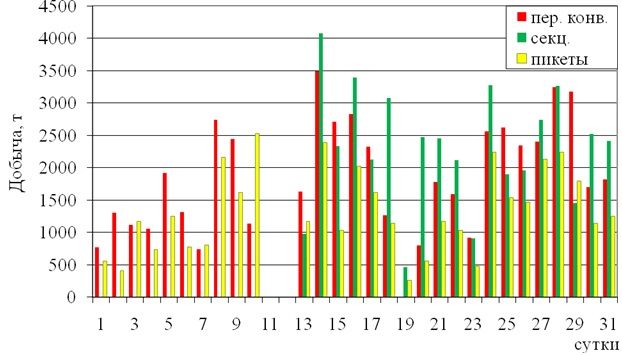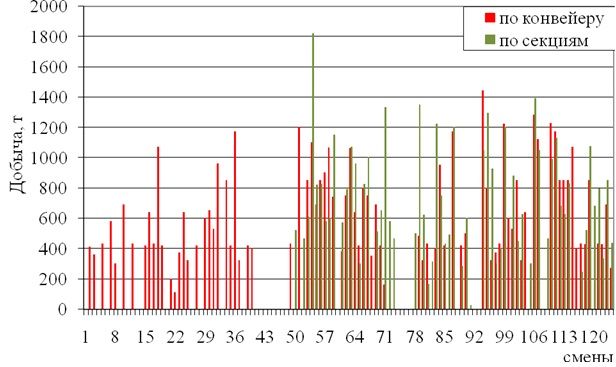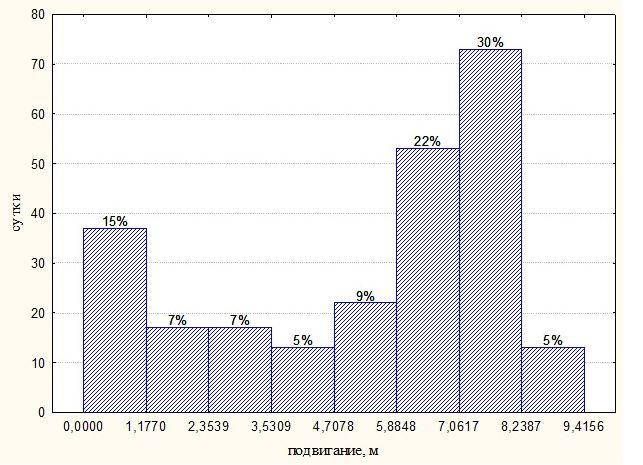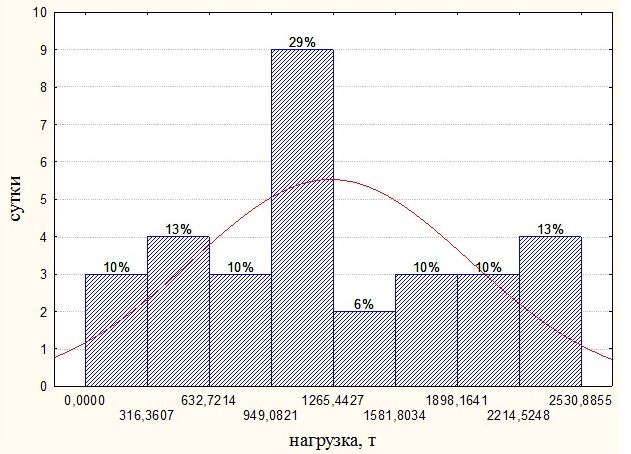

Industry in Ukraine has received a great development due to the presence in the depths of the vast number of minerals [1]. The country's economy depends on the country's industrial potential, so it is industry plays a huge role in the development of Ukraine.
Coal in Ukraine is the main source of energy, so the work of the coal industry depends on the state of the state's economy.
The technological process of extraction of minerals in the mine underground transport is one of the most important links. The purpose of it is shipping the rock mass in mine workings from the bottom to the barrel of mine, transport equipment and materials from the trunk to the work site, as well as transportation of people underground mines to their place of work.
A variety of operational and technological conditions at the mining enterprises puts specific requirements on the transportation system and adjust the standards of reliability of the transport complex. Rise in the cost of handling and transport equipment requires a substantial increase in the efficiency of their operation, establish a rational level of operational reliability of transportation vehicles and in general the transport complex of coal mines.
Accident, which, unfortunately, very often occur in mines, have a great impact on the entire process: the work of the transport complex, coal, etc [1], [2]. Reducing the number of accidents will increase production, reduce injuries and reduce the number of stoppages of transportation equipment of the mine. In order to reduce the number of accidents is necessary to do a lot of work to analyze the vast amount of data, which in turn will allow for the forecast efficiency of the transport system of a coal mine with a certain degree of reliability.
This issue is devoted to this work.
Currently, most research organizations involved in further development of transport schemes and development activities to enhance the reliability of transport equipment and complex as a whole. Important role in the development of these issues was played by the following scholars and researchers: Berezhnoy VI, Resurrection, TP, Nekrasov, AG, Zaitsev, EI and others.
In Ukraine, research and academic institutions, including public DonUGI, MakNDI, Donetsk National Technical University, work on the development of new advanced methods of selecting and determining the reliability of transport systems and introducing them to life. Very interesting against this background that looks like the proposed method. Work to support activities to enhance the reliability of the transport complex mine technically and economically justified. To obtain the greatest economic impact must take into account not only geological and mining technical conditions, the degree and mode of loading of vehicles, as well as time to apply measures to prevent accidents. So issue is relevant.
Objective — Substantiation of measures improving the reliability of the transport complex of mine on the basis of predicting equipment failures, which will ensure effectiveness of mine as a whole.
To achieve this goal were as follows:
1) an analysis of freight and cargo;
2) to analyze the duration of excavation equipment;
3) to analyze accidents and to construct the distribution of accidents;
4) support activities improving the reliability of transport complex of mines;
5) make the conclusions of the study.
Based on data obtained from the dispatch log 4 th southern lava unit 10 have been analyzed changes in freight traffic, the duration of the combine and the accident rate. In this case, we studied the reasons for reducing freight traffic, increasing delays and accidents, which made it possible to analyze the variation of the cargo 4 th southern lava over time (shifts and days).
Fig. 1 shows a diagram of the daily, and Fig. 2 shifts production of the 4 th of lava on the south, where different colors show production [2], [3], calculated in various ways. Red displays output, defined by gate valves face conveyor, green — on the passage of specific sections of the combine mechanized system, and yellow — by pickets at the beginning of I-th shift.

Fig. 1. Daily production.
It is seen that the data mining some ways quite different from each other and the big production values obtained by using calculations on the location of the combine. However, in determining production by this method shall be based on the hypothesis that the excavation work at the combine executive body embedded in the coal mass in the entire width of the capture. However, the operational data for several mining companies shows that the actual value used width excavation combine a random deviations from the standard in the smaller side, provided the technology, and the average value of the actual width of 0,3-0,6 of the standard.
Deviation in the lower side of the actual value stope due to several factors, such as alignment lines slaughter transitions zones violations, maneuvering separate sections, etc.

Fig. 2. Interchangeable output.
View of the above can be stated that production on the 4 th South lava is:
• by shifting the pipeline — 53,753 tonnes per month.;
• on the combine — 43,917 tonnes per month.;
• on pickets — 38,624 tonnes per month.
value of production calculated by the gate valves and pipeline excavation Status combine, do not show the actual production, since the calculations of these quantities are directly dependent on
width processor. It should also be noted that data mining designed to locate, However, even this relationship is not absolutely reliable, since allowable load is determined based on the hypothesis of constancy of gas content in the range
excavation site. In fact, this foulness is a random variable having a significant scatter (± 50% or more) which is due to natural variation
geological factors. This means that the calculated allowable load on the lava is not a constant value, and its value has a range of ± 50%. K
Unfortunately not known in advance the value of the permissible regulatory burden in a particular area excavation of the site. In this regard, a methodology for calculating the load on the lava
should be changed, and the results of the design must be probabilistic in nature, which is today still unacceptable to the operatives.
Similar studies magnitude podviganiya lava were [4] performed according to the German coal mines. Fig. 3 is a graph podviganiya lava
over 275 days of the excavation site.
Fig. 3. Distribution podviganiya lava. Analyzing Fig. 3, we can conclude that the work of cleaning [5] face on the chart is clearly seen as the regimes of stable and not stable
work. In this case, the chart clearly identified two modes of operation of a lava in which the regulatory burden has changed, from larger to smaller ranging from 238 days.
Figure 4 shows the distribution podviganiya lava, which identified two modes, one of which corresponds to the downtime for this period of time,
and the second maximum podviganiyu. From the histogram shows that the mode corresponding podviganiyu coincides with the regulatory load, with load is performed in 30%. Fig. 4. The distribution of the 4 th southern lava unit 10. Plotting the distribution of freight 4-th southern lava unit 10 (Fig. 4), we can analyze the operation of the site. From Fig. 4. that the distribution is
approximately
symmetrical form, and fashion is located in an area 0,3-0,5 of the regulatory burden. In this case, the actual implementation of the regulatory burden by only 13%
cases.
It is also worth noting that the histogram distribution podviganiya lava American mines idle percentage is 15% of the entire period of work, and
percentage
downtime 4 th southern lava unit 10 is 10%. Also note that the percentage of work within the regulatory burden according to the American mines is 30%, and
according to the 4 th South Lava — 13%. This suggests that when working
4-th southern lava width of the executive body of the standard excavation harvester. And so with a smaller percentage of idle time is not observed a higher
percentage of
of lava from the regulatory load.
Summarizing the foregoing [6], evaluation of the mine, podviganie which describes the graph in Figure 4 can be considered as part of a stable regime,
as the fashion
distribution is located on the right side of the graph corresponds to the regulatory burden on the breakage face, and work on 4-th South lava unit 10 as an
unstable regime
work as well as fashion is centered at the graphics and corresponds to approximately 0,3-0,5 of the regulatory load [7] on the breakage face. However,
for a more complete picture
of the 4-th southern lava unit 10 to collect more data and only in this case, we can draw final conclusions about the stability of the
excavation site.
In the future we plan to choose a rational method of predicting, forecasting parameters to justify and implement a direct forecast failure of transport equipment.
Fig. 5. The operating principle of lining.
(volume – 49,9 КБ; number of frames – 5; duration – 7 с.) 1. The main reason for failure of planned production is an unfavorable geological situation[8], [9], in particular low-amplitude faults and replacement of durable
sandstone reservoir. Therefore, to develop a predictive model to improve the reliability of the transport sector need reliable information on violations. The
reliability of modern methods of geophysical prospecting is less than 55%-60%, therefore a promising methodology allows to increase the reliability prediction
of geological environment is artificial neural networks. However, as input for training the neural network requires data of geophysical imaging of the coal seam.
2. The average duration of excavation combine for the month was 3.9 hours or 65.3%. The average duration of excavation combine in shifts are approximately equal.
The greatest amount of time grain has a range of 4 to 6 hours while the actual production in a few times (2-4.5 times) smaller than the calculated value, it can be
argued that a major role in this is part of the executive body width excavation combine. Work excavation equipment in this mode leads to an increase in the cost
elements of coal for electricity, materials and wages [10].
3. The greatest number of accidents for more than 80% relates to an incident arising directly on the excavation site and accidents associated with transportation
of minerals. The distribution of accidents on the duration shows that the greatest number of accidents occurred per month in the range from 0 to 131 minutes. 1. Сафонов Г.Н., Мотин П.А. Машинист шахтных локомотивов. М.: Недра, 1985. — 276с.
2. Степанов А.В. Факторы, влияющие на надежность грузового автомобиля при работе на породных отвалах // Автомобильный транспорт: сб. научн. тр. — Харьков:
ХНАДУ. — 2003. — Вып. 13 — С. 140 – 142.
3. Степанов А.В., Полянский А.С. Сезонное рассеивание показателей надежности автомобилей, работающих на породных отвалах // Автомобильный транспорт: сб. научн.
тр. — Харьков: ХНАДУ. — 2004. – Вып. 15 — С. 96 — 99.
4. Степанов А.В. Надежность транспортных систем породных отвалов // Автомобильный транспорт: сб. научн. тр. — Харьков: ХНАДУ. — 2006. — Вып. 19 — С.
113 — 116.
5. Гнеденко Б.В., Беляев Ю.К., Соловьев А.Д. Математические методы в теории надежности. — М.: Наука, 1965. — 524 с.
6. Барлоу Р., Прошан Ф. Статистическая теория надежности и испытания на безотказность. — М.: Наука, 1984. — 328 с.
7. Дедков В.К., Северцев Н.А. Основные вопросы эксплуатации сложных систем. — М.: Высшая школа, 1976. — 406 с.
8. Барзилович Е.Ю. Модели технического обслуживания сложных систем. — М.: Высшая школа, 1982. — 231 с.
9. Дмитрюк Г.Н., Пясик И.Б. Надежность механических систем. — М.: Машиностроение, 1966. — 184 с.
10. Гихман И. И., Скороход А. В. Введение в теорию случайных процессов. М. — Наука, 1969 — 326 с.



Conclusions
Literature
Resume | Up